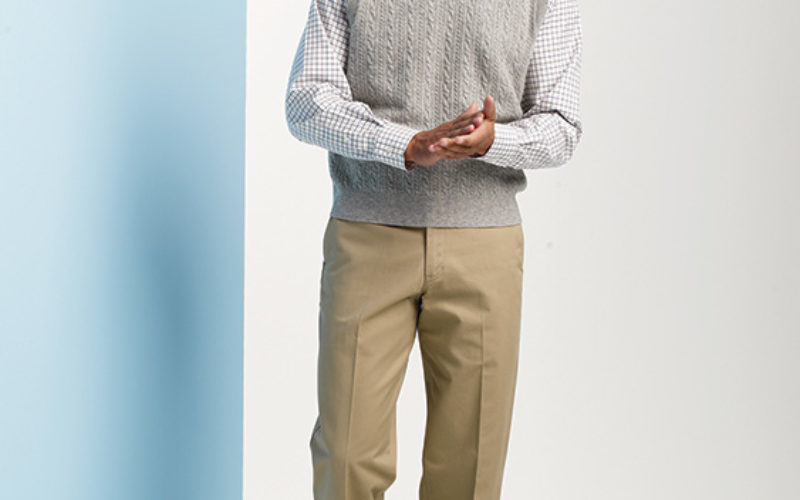Q. It seems like the leading stores are showing models and mannequins dressed with disco era tightness. What is the correct way trousers should fit today?
A. Even though men’s clothes in general are classic and stable, some changes do occur, even if at a glacial pace. In recent seasons, men’s clothes have been getting shorter and slimmer. This is most apparent in the length of jackets and coats and, as you have noticed, in the trim cut of trousers/pants. The picture you referenced in your email was of chinos that indeed are much tighter than in the past.
When it comes to men’s pants, there are three basic categories which have very distinct levels of formality and fits: dress trousers, chinos, and jeans.
- Dress trousers are either part of a matched suit or they may be “odd trousers” (the clothing industry’s term for men’s nice trousers that are not part of a suit and that are sold and worn separately, without a matching jacket). They are cut fuller than chinos or jeans. Dress pants are usually made of wool or some sort of wool blend that’s softer and finer than cotton, which makes them dressier.
- Chinos are casual cotton pants in the middle category between dress pants and jeans. More casual than dress trousers and more dressy than jeans, they are versatile and fashionable. This must-have style is basic for every man. Not only are they perfect for casual looks, but they also work with dressier combinations. They come in cotton and cotton-blends, and their wide range of colors is a nice plus. Traditional dressers are dedicated to them as an adult alternative to jeans.
- Jeans are the most informal. Made of rugged denim, they are standard casual fare. Fit is the primary option for jeans and many men have a tighter “dress” pair for going out casually and a looser pair for work, comfort, and/or home
Of the three types of pants, chinos are the most popular and the most essential outside of work and home. They also are most affected by style changes. The fit of today’s chinos is indeed getting very narrow. Correct fit, neither too tight nor too baggy, is key to making chinos work. Generally, they are designed to skim the body. You can’t go wrong with a “slim but not skinny” approach. Regardless of what you see in ads, stores, or on 23-year-olds, here’s how chinos should fit:
The Waist – When the waist fits perfectly, you won’t actually need a belt to hold your pants up–but you should still wear one!
The Hips/Seat – Avoid excess fabric in the seat, but be sure you can bend over without pulling a seam.
The Rise – The rise on pants (the distance from the crotch seam to the top of the waistband, which determines where pants sit on the body) is not easy to alter, so be sure the pants fit well in the seat before you buy them. Avoid super low-rise chinos.
The Thighs – You want a close fit without feeling any restriction in movement (in other words, slim, but not skin-tight).
The Calves – Depending on how currently stylish you want to be, choose chinos on the slim side.
The Length – It depends on how much break you want, but I never like the look of too-short “flood pants.”
In summary, modern chino pants look best with a bit of a closer fit, but be sure you choose what feels comfortable. While it may be sometime before you hit a “disco” in our current normal, when you do, you’ll want to look good and in style, but not show everything and risk splitting your pants!
Please send your men’s dress and grooming questions to MALE CALL: Lois.Fenton@prodigy.net









